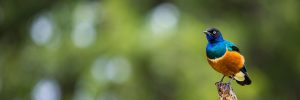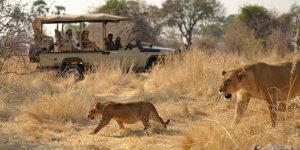Ruaha National Park is the largest national park in Tanzania. The addition of the Usangu Game Reserve and other important wetlands to the park in 2008 increased its size to about 20,226 square kilometres (7,809 sq mi), making it the largest park in Tanzania and East Africa.
The park is about 130 kilometres (81 mi) west of Iringa. The park is a part of the 45,000 square kilometres (17,000 sq mi) Rungwa-Kizigo-Muhesi ecosystem, which includes the Rungwa Game Reserve, the Kizigo and Muhesi Game Reserves, and the Mbomipa Wildlife Management Area.
The name of the park is derived from the Great Ruaha River, which flows along its southeastern margin and is the focus for game-viewing. The park can be reached by car on a dirt road from Iringa and there are two airstrips – Msembe airstrip at Msembe (park headquarters), and Jongomeru Airstrip, near the Jongomeru Ranger Post.
Climate
Ruaha National Park has a bimodal pattern of rain forest; the short rainfall season begins November to February, while the long season is between March and April. The annual mean rainfall ranges between 500mm-800mm with the average annual temperature of about 280c. The park experiences its dry season between June and October when the temperature at Msembe headquarter reaches 350c.
Tourism Attractions
The park formerly was known for its large elephant population, numbering 34,000 in the Ruaha-Rungwa ecosystem in 2009 but only 15,836 (plus or minus 4,759) in 2015.
More than 571 species of birds have been identified in the park. Among the resident species are hornbills. Many migratory birds visit the park.
Other noted animals found in this park are cheetah, African leopard, lion (Africa’s second largest population, representing 10 percent of the world population), African wild dog (third largest population in the world), spotted hyena, giraffe, hippopotamus, African buffalo, and sable antelope. The best times to visit for predators and large mammals is during the dry season (May–December) and for birds and flowers, during the wet season (January–April).
Birds

The park is one of the Tanzania birds’ paradise with more than 571species and some of them are known to be migrants from within and outside Africa. Migrating species from Europe, Asia, Australian rim and Madagascar have been recorded in the park. Species of interest in the park include Ruaha red-billed hornbill (Tokus ruahae) which is dominant in the area. The recently annexed wetland, the Usangu basin is one of the country’s important bird area (IBA) as recognized by Birdlife International. Though birds can be seen all the year around, the best time for bird watching is during the wet season.
Animals

Ruaha is believed to have high concentration of elephants than any national park in East Africa. It is also a place where, magnificent mammals like Kudu (both Greater and Lesser), Sable and Roan antelopes can easily be spotted in Miombo woodland. The male Kudu have beautiful spiraled horns while male Sable antelope have impressive curved horns. The park is also a habitat for endangered wild dogs. Other animals in the park include lions, leopards, cheetah, giraffes, zebras, elands, impala, bat eared foxes and Jackals.
Reptiles and Amphibians
Apart from large animals, the park also harbors a number of reptiles and amphibians such as crocodiles, poisonous and non-poisonous snakes, monitor lizards, agama lizards and frogs. The Great Ruaha and Mzombe rivers are presumably the most preferred habitat for crocodiles.
Vegetation
The park is characterized by semi-arid type of vegetation, baobab trees, Acacia and other species. There are over 1650 plant species that have been identified. The park is the transitional point of two vegetation zones, the Zambezian (characterized by Miombo vegetation) and Sudanian (characterized by Acacia vegetation). Historical and cultural sites
There are several historical and cultural sites in the park which offer a visitor a chance to explore the Southern Tanzanian tribes. The early trade routes used by the Arab caravan crossed here. In 1830 these coastal traders expanded their routes northward, and in year 1857 to 1858 other European explorers such as Burton and Speke used these routes too. Chief Mkwawa used the same routes to visit his chiefdoms in Sangu and Gogo.
The park area often hailed as the land of the brave Chief Mkwawa, the Chief of the hehe people who resisted against the German attack in the late 19th century. The fierce and successful battle tactics against the German invasion made the Hehe tribe famous in the Southern highland of the then Tanganyika (Tanzania). The Hehe tribe under the leadership of chief Mkwawa was dominant around the Ruaha area. Some of the outcrops in the area are known as hiding places of chief Mkwawa who went into hiding after the fall of his empire (kalenga) to the German in 1894. In brief, it is believed that, this ancient land (Ruaha National Park) holds many secrets of chief Mkwawa.
Some of the cultural sites that were used for rituals are “Ganga la Mafunyo”, Nyanywa and Chahe, Painting rock at Nyanywa, the “Gogo” chief “Mapenza” grave at Mpululu and “Mkwawa” spring area believed to be used by Chief Mkwawa. Other historical sites near the park include Isimila pillars near Iringa town, Kalenga, Mlambalasi, Lugalo and God’s bridge just to mention a few.
Physical feature
Ruaha National Park has a wide range of physical features from the Great Rift Valley, river systems, natural springs, wetlands, hot water springs, and kopjes to the beautiful rolling hills and mountains.
Rivers
The river systems and watershed are of economic, social and ecological significance for the park itself and country at large. Main rivers include the Great Ruaha, Mzombe, Mdonya, Mwagusi and Jongomero.
Rift valley
The Great Rift Valley crosses the park. The escarpment wall along the western valley side is about 50-100m high in the north-eastern parts, increasing in height to the southwest. It is considered that, the valley of the Great Ruaha River is an extension of the Great Rift Valley. The Great Ruaha River flows for 160km long along the entire eastern boundary through rugged gorges and open plains.
Natural springs
They occur throughout the park and they are associated with the base of the Western Rift Valley escarpment, most notably Mkwawa, Mwayembe, Makinde and Majimoto springs. These are dry season refugees for wildlife and when most of the rivers get dry.
Undulating landscape
The park has undulating land and hills including kilimamatonge, Nyamasombe, Nyanywa, Chariwindwi, Igawira, Mwayiui, Kibiriti, Magangwe, Ndetamburwa and Isukanvyiola. These act as kopjes creating good habitat for animals such as klipspringer which normally can be seen in some of these hills.


